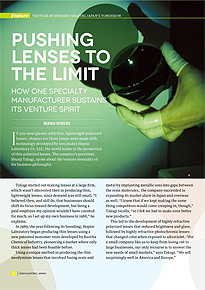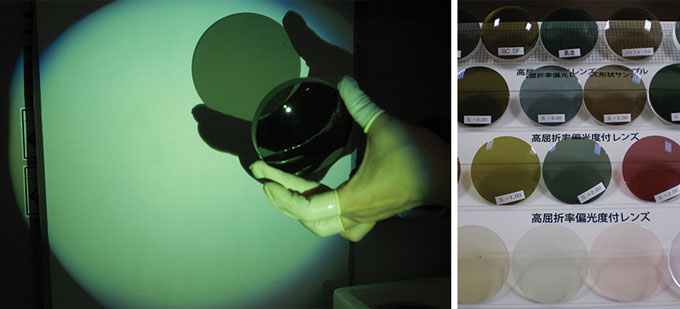Home > Highlighting JAPAN >Highlighting Japan September 2014>Venture Businesses: Shaping Japan’s Tomorrow
Highlighting JAPAN

Venture Businesses: Shaping Japan’s Tomorrow
Pushing Lenses to the Limit
How One Specialty Manufacturer Sustains Its Venture Spirit

If you wear glasses with thin, lightweight polarized lenses, chances are those lenses were made with technology developed by lens maker Hopnic Laboratory Co. Ltd., the world leader in the production of thin polarized lenses. The company's president, Shunji Takagi, spoke about the venture mentality of his business philosophy.
Takagi started out making lenses at a large firm, which wasn't interested then in producing thin, lightweight lenses, since demand was still small. "I believed then, and still do, that businesses should shift its focus toward development, but being a paid employee my opinion wouldn't have counted for much, so I set up my own business in 1988," he explains.
In 1989, the year following its founding, Hopnic Laboratory began producing thin lenses using a new patented monomer resin developed by Kureha Chemical Industry, pioneering a market where only thick lenses had been feasible before.
Using a unique method in producing the thin neodymium lenses that involved fusing resin and metal by implanting metallic ions into gaps between the resin molecules, the company succeeded in expanding its market share in Japan and overseas as well. "I knew that if we kept making the same thing competitors would come creeping in, though," Takagi recalls, "so I felt we had to make even better new products."
This led to the development of highly refractive polarized lenses that reduced brightness and glare, followed by highly refractive photochromic lenses that changed color when exposed to ultraviolet. "For a small company like us to keep from losing out to large businesses, our only recourse is to answer the new needs of small markets," says Takagi. "We sell surprisingly well in America and Europe."
Highly refractive polarized lenses, for which Hopnic Laboratory holds close to 90 percent of the world's market share, contain a polarizing layer of film inside. Since the methods for making polarizing film were mostly secret, the company had to devise the necessary manufacturing equipment and everything else on its own, and then spend a long time establishing the technology to get the film into the lenses. "There are now six or seven companies in the world that make polarizing film, but if you want quality you have to go with Hopnic products," Takagi says with confidence.
Since the company is too small to do mass production, Takagi develops products that answer special needs arising from, say, changes in eyesight according to the living environment or due to aging. Since research and development requires time, he says he has to foresee market demand about eight years down the road. And although Hopnic Laboratory holds four patents, at the product development stage it must check an enormous amount of patent-related material every two years or so to confirm if any other company has already patented the technology.
In 2014, Hopnic Laboratory made it into the "Global Niche Top Companies Selection 100" of the Ministry of Economy, Trade and Industry. Takagi is now developing businesses focused on as-yet-untouched markets—such as films using new materials, and photochromic preparations applied to lens surfaces—aiming to increase sales threefold to three billion yen in five years. "We're a small company in the world of lenses, but using the Small & Medium Enterprises Venture Fund and startup funds from the Small and Medium Enterprise Agency, we have been able to do R&D on lenses," says Takagi. "The fact that the present government strongly supports ventures is very encouraging."
Making Hopnic Laboratory the number one maker of functional lenses in the world is Takagi's aspiration. "Being number one in global market share for highly refractive modified lenses should not have us resting on our laurels," Takagi states. "I want us to reach the top in other markets where we can compete. That would increase the scale of our market, and we could lower the prices of our products. I want Hopnic Laboratory's products used not just by high-end customers but by many people all over the world."
© 2009 Cabinet Office, Government of Japan






